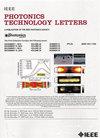声光移频器的热效应及其对光学计量的影响
IF 2.5
3区 工程技术
Q2 ENGINEERING, ELECTRICAL & ELECTRONIC
引用次数: 0
摘要
声光移频器(AOFS)是光学测量中的关键部件,包括长度、速度和频率测量等应用。声光晶体在工作过程中受到热积累的影响,导致其光学和物理性质发生显著变化。其结果是,AOFS衍射光束会发生相位漂移和频率漂移,降低了光学计量系统的测量精度。在这篇文章中,我们评估了$1^{\text {st}}$阶衍射光束由于热效应通过AOFS时的路长和光频波动。我们的实验揭示了路径长度漂移率和频率漂移与温度漂移率之间的线性关系。测量到的比例系数分别为$0.791~\mu $ m/K和1.019 Hz/K/s。在热平衡条件下,aofs在距离、速度和频率测量中贡献的本底噪声分别为$\sim ~100$ pm(平均时间100 ms)、$2.5~\mu $ m/s(平均时间1 ms)和$1.56\times 10 ^{-20}$(平均时间10000 s)。本文章由计算机程序翻译,如有差异,请以英文原文为准。
Thermal Effect of Acousto-Optic Frequency Shifter and Its Impact on Optical Metrology
Acousto-optic frequency shifter (AOFS) is the key component in optical metrology, encompassing applications such as length, velocity, and frequency measurements. The acousto-optic crystal suffers from thermal accumulation during operation, leading to significant changes in its optical and physical properties. As a result, the diffracted beam of an AOFS undergoes phase and frequency drift, degrading the measurement precision of optical metrology systems. In this letter, we evaluate the path length and optical frequency fluctuation of the $1^{\text {st}}$ -order diffracted beam passing through an AOFS due to thermal effect. Our experiment reveals linear correlation between both path length drift rate and frequency drift versus temperature drift rate. The measured proportionality factor are $0.791~\mu $ m/K and 1.019 Hz/K/s, respectively. Under thermal equilibrium conditions, AOFS-contributed noise floor in distance, velocity and frequency measurement are $\sim ~100$ pm at 100 ms averaging time, $2.5~\mu $ m/s at 1 ms averaging time, and $1.56\times 10 ^{-20}$ at 10,000 s averaging time, respectively.
求助全文
通过发布文献求助,成功后即可免费获取论文全文。
去求助
来源期刊

IEEE Photonics Technology Letters
工程技术-工程:电子与电气
CiteScore
5.00
自引率
3.80%
发文量
404
审稿时长
2.0 months
期刊介绍:
IEEE Photonics Technology Letters addresses all aspects of the IEEE Photonics Society Constitutional Field of Interest with emphasis on photonic/lightwave components and applications, laser physics and systems and laser/electro-optics technology. Examples of subject areas for the above areas of concentration are integrated optic and optoelectronic devices, high-power laser arrays (e.g. diode, CO2), free electron lasers, solid, state lasers, laser materials'' interactions and femtosecond laser techniques. The letters journal publishes engineering, applied physics and physics oriented papers. Emphasis is on rapid publication of timely manuscripts. A goal is to provide a focal point of quality engineering-oriented papers in the electro-optics field not found in other rapid-publication journals.
 求助内容:
求助内容: 应助结果提醒方式:
应助结果提醒方式:


